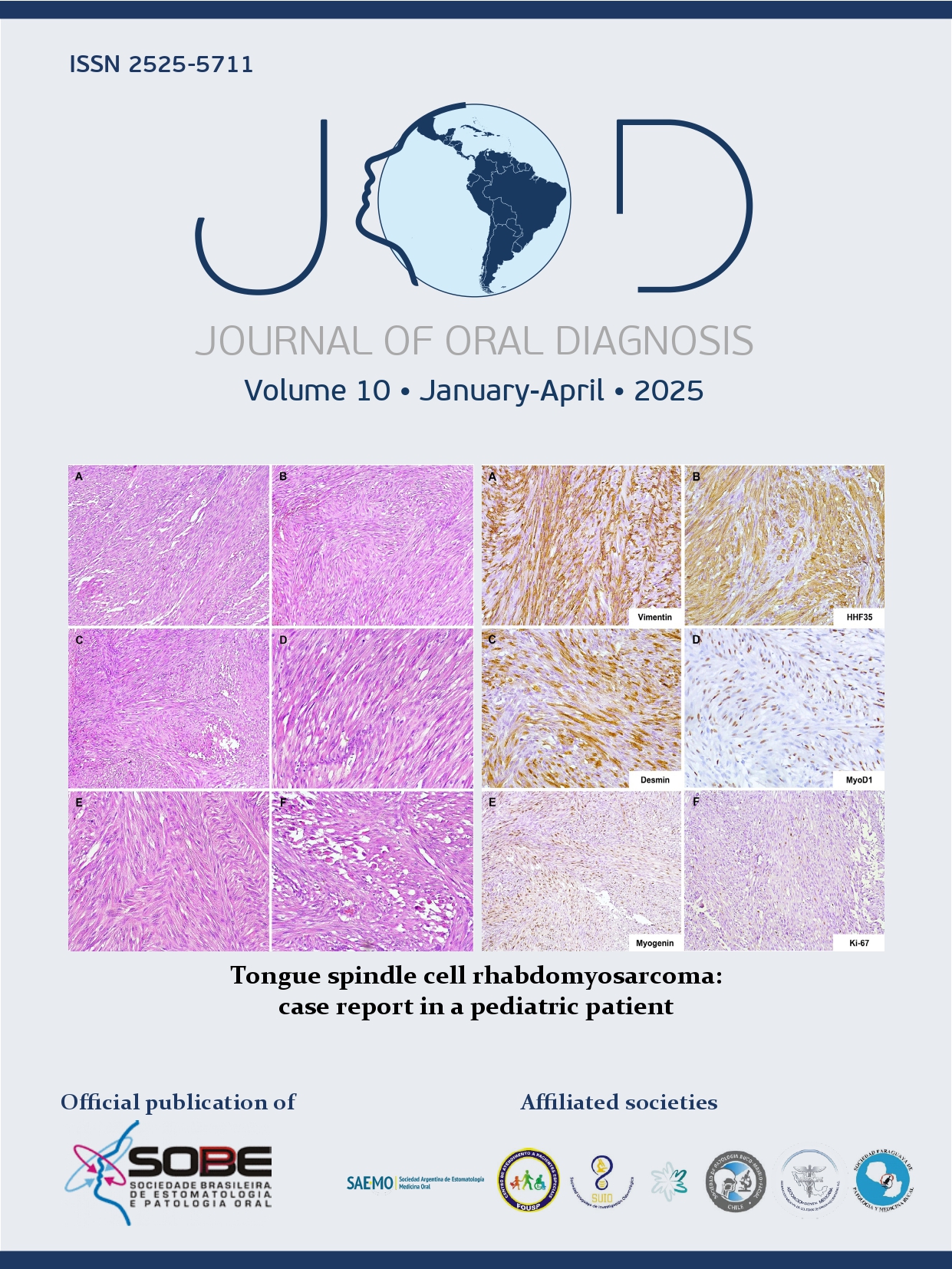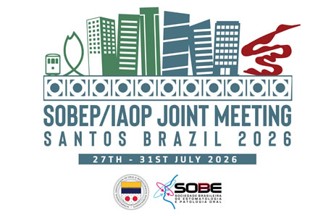Dental anomalies in a patient with Tyrosinemia type I: first case report in the literature
DOI:
https://doi.org/10.5327/2525-5711.284Keywords:
Tyrosinemia, Fanconi Syndrome, Hydrolases, Tooth AbnormalitiesAbstract
Objective: This clinical report describes a 13-year-old female with a complex medical history and multisystemic symptoms, including lower-extremity deformities, hypercalciuria, low body mass, short stature, abdominal pain, seizures, and hypertension. Case report: Despite an initial clinical diagnosis of nonspecific renal tubular acidosis, further investigation revealed a likely pathogenic homozygous variant in the FAH gene, indicating the diagnosis of tyrosinemia type I (HT1). During the investigation, several dental anomalies were detected in this patient (tooth decay, delayed eruption, hypoplastic enamel, and changes in tooth shape). The patient has been receiving dietary adaptations and electrolyte and alkaline solutions supplementation and is under close medical and dental follow-up care. Practical implications: The aim of this report is to highlight the importance of a thorough investigation and genetic testing in patients with multisystemic symptoms and the possibility of oral manifestations and dental anomalies in association with renal tubular disorders, including Tyrosinemia type I.
References
Phaneuf D, Labelle Y, Bérubé D, Arden K, Cavenee W, Gagné R, et al. Cloning and expression of the cDNA encoding human fumarylacetoacetate hydrolase, the enzyme deficient in hereditary tyrosinemia: assignment of the gene to chromosome 15. Am J Hum Genet. 1991;48(3):525-35. PMID: 1998338.
Bartlett DC, Preece MA, Holme E, Lloyd C, Newsome PN, McKiernan PJ. Plasma succinylacetone is persistently raised after liver transplantation in tyrosinaemia type 1. J Inherit Metab Dis. 2013;36(1):15-20. https://doi.org/10.1007/s10545-012-9482-1
Kubo S, Sun M, Miyahara M, Umeyama K, Urakami K, Yamamoto T, et al. Hepatocyte injury in tyrosinemia type 1 is induced by fumarylacetoacetate and is inhibited by caspase inhibitors. Proc Natl Acad Sci U S A. 1998;95(16):9552-7. https://doi.org/10.1073/pnas.95.16.9552
Roth KS, Carter BE, Higgins ES. Succinylacetone effects on renal tubular phosphate metabolism: a model for experimental renal Fanconi syndrome. Proc Soc Exp Biol Med. 1991;196(4):428-31. https://doi.org/10.3181/00379727-196-43211
Jorquera R, Tanguay RM. Fumarylacetoacetate, the metabolite accumulating in hereditary tyrosinemia, activates the ERK pathway and induces mitotic abnormalities and genomic instability. Hum Mol Genet. 2001;10(17):1741-52. https://doi.org/10.1093/hmg/10.17.1741
Chinsky JM, Singh R, Ficicioglu C, van Karnebeek CDM, Grompe M, Mitchell G, et al. Diagnosis and treatment of tyrosinemia type I: a US and Canadian consensus group review and recommendations. Genet Med. 2017;19(12). https://doi.org/10.1038/gim.2017.101
Morrow G, Tanguay RM. Biochemical and clinical aspects of hereditary tyrosinemia type 1. In: Tanguay RM, editor. Hereditary tyrosinemia: pathogenesis, screening and management. Advances in Experimental Medicine and Biology. Cham: Springer International Publishing; 2017. p. 9-21. https://doi.org/10.1007/978-3-319-55780-9_2
Tanguay RM, Valet JP, Lescault A, Duband JL, Laberge C, Lettre F, et al. Different molecular basis for fumarylacetoacetate hydrolase deficiency in the two clinical forms of hereditary tyrosinemia (type I). Am J Hum Genet. 1990;47(2):308-16. PMID: 2378356.
Demers SI, Russo P, Lettre F, Tanguay RM. Frequent mutation reversion inversely correlates with clinical severity in a genetic liver disease, hereditary tyrosinemia. Hum Pathol. 2003;34(12):1313-20. https://doi.org/10.1016/s0046-8177(03)00406-4
van Spronsen FJ, Thomasse Y, Smit GP, Leonard JV, Clayton PT, Fidler V, et al. Hereditary tyrosinemia type I: a new clinical classification with difference in prognosis on dietary treatment. Hepatology. 1994;20(5):1187-91. PMID: 7927251.
Lindblad B, Lindstedt S, Steen G. On the enzymic defects in hereditary tyrosinemia. Proc Natl Acad Sci U S A. 1977;74(10):4641-5. https://doi.org/10.1073/pnas.74.10.4641
Chinsky JM, Singh R, Ficicioglu C, van Karnebeek CDM, Grompe M, Mitchell G, et al. Diagnosis and treatment of tyrosinemia type I: a US and Canadian consensus group review and recommendations. Genet Med. 2017;19(12). https://doi.org/10.1038/gim.2017.101
Daou KN, Barhoumi A, Bassyouni A, Karam PE. Diagnostic and therapeutic challenges of hereditary tyrosinemia type 1 in Lebanon: a 12-year retrospective review. Front Pediatr. 2021;9:698577. https://doi.org/10.3389/fped.2021.698577
Mitchell GA, Grompe M, Lambert M, Tanguay RM. Hypertyrosinemia. In: Adam MP, Feldman J, Mirzaa GM, Pagon RA, Wallace SE, Amemiya A, eds. GeneReviews®. Seattle: University of Washington; 1993-2025.
Sniderman King L, Trahms C, Scott CR. Tyrosinemia type I. In: Adam MP, Feldman J, Mirzaa GM, Pagon RA, Wallace SE, Amemiya A, eds. GeneReviews®. Seattle: University of Washington, Seattle; 1993-2025.
Lindstedt S, Holme E, Lock EA, Hjalmarson O, Strandvik B. Treatment of hereditary tyrosinaemia type I by inhibition of 4-hydroxyphenylpyruvate dioxygenase. Lancet. 1992;340(8823):813-7. https://doi.org/10.1016/0140-6736(92)92685-9
Ferreira SBP, Aquino SN, Pereira PCB, Silva ACS, Martelli-Júnior H. Dental findings in Brazilian patients with Fanconi syndrome. Int J Paediatr Dent. 2016;26(1):77-80. https://doi.org/10.1111/ipd.12183
Martelli-Júnior H, Ferreira SP, Pereira PCB, Coletta RD, Aquino SN, Miranda DM, et al. Typical features of amelogenesis imperfecta in two patients with Bartter’s Syndrome. Nephron Extra. 2012;2(1):319-25. https://doi.org/10.1159/000345801
Holme E, Lindstedt S. Tyrosinemia type I and NTBC (2-(2-nitro-4-trifluoromethylbenzoyl)-1,3-cyclohexanedione). J Inherit Metab Dis. 1998;21(5):507-17. https://doi.org/10.1023/a:1005410820201
Published
How to Cite
Issue
Section
License
Copyright (c) 2025 Hercílio Martelli-Júnior, Hélen Kaline Farias Bezerra, Anna Luiza Braga Albuquerque, Rodrigo Rezende Arantes, Marcelo Augusto de Oliveira Sales, Felipe Paiva Fonseca, Renato Assis Machado, Ana Cristina Simões e Silva

This work is licensed under a Creative Commons Attribution 4.0 International License.













